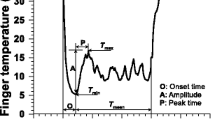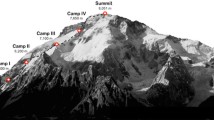Abstract
Cold water immersion and protective gloves are associated with decreased manual performance. Although neoprene gloves slow hand cooling, there is little information on whether they provide sufficient protection when diving in cold water. Nine divers wearing three-fingered neoprene gloves and dry suits were immersed in water at 25 and 4°C, at depths of 0.4 msw (101 kPa altitude adjusted) and 40 msw (497 kPa) in a hyperbaric chamber. Skin temperatures were measured at the fingers, hand, forearm, chest and head. Grip strength, tactile sensitivity and manual dexterity were measured at three time intervals. There was an exponential decay in finger and back of hand skin temperatures with exposure time in 4°C water. Finger and back of hand skin temperatures were lower at 40 msw than at 0.4 msw (P < 0.05). There was no effect of pressure or temperature on grip strength. Tactile sensitivity decreased linearly with finger skin temperature at both pressures. Manual dexterity was not affected by finger skin temperature at 0.4 msw, but decreased with fall in finger skin temperature at 40 msw. Results show that neoprene gloves do not provide adequate thermal protection in 4°C water and that impairment of manual performance is dependent on the type of task, depth and exposure time.





Similar content being viewed by others
Notes
Eta-squared (η2) is a frequently reported estimate of the strength of the association between the independent and dependent variables. However, it is often misreported due to confusion between classical and partial η2 (Pierce et al. 2004). Classical η2 is defined as the proportion of the total variance explained by a single factor, the sum provides a measure of the explained variance and has a value between 0 and 1. Partial η2, defines the proportion of the variation that is attributed to a single factor when the non-error variation due to other factors is exluded (partialed out). Hence it provides a measure of the strength of association for that factor.
References
Adolfson JA, Sperling L, Pettersson S (1980) Funktionsstudie av dykarhandskar. Nat Swedish Defence Res Inst, Stockholm, Report C 58007-H9
Adolfson JA, Sperling L, Gustavsson M (1984) Hand protection in cold water diving. In: Ice Dive 84. International conference on medical and technological problems of diving and related underwater activities in Arctic conditions. Nordic Council for Arctic Medical Research and the Society for Underwater Technology, Stockholm, June 3–6, pp 345–369
Bowen HM (1968) Divers performance and the effects of cold. Human Factors 10:445–464
Chen F, Nilsson H, Holmer I (1994) Finger cooling by contact with cold aluminium surfaces: effects of pressure, mass and whole body thermal balance. Eur J Appl Physiol 69:55–60
Daanen H (1993) Deterioration of manual performance in cold and windy climates. In: Advisory group for Aerospace Research and Development Conference Proceedings 540: the support of air operations under extreme hot and cold weather conditions, pp 15.1–15.10
Enander A (1984) Performance and sensory aspects of work in cold environments: a review. Ergonomics 27:365–378
Enander A (1998) Effects of thermal stress on human performance. Ergonomics 30:1431–1445
Fox WF (1967) Human performance in the cold. Human Factors 9:203–220
Gaydos H, Dusek E (1958) Effects of localized hand cooling versus total body cooling on manual performance. J Appl Physiol 12:377–380
Giesbrecht G, Bristow G (1992) Decrement in manual arm performance during whole body cooling. ASEM 63:1077–1081
Giesbrecht G, Wu M, White M, Johnston C, Bristow G (1995) Isolated effects of peripheral arm and central body cooling on arm performance. ASEM 66:968–975
Havenith G, van de Linde EJG, Heus R (1992) Pain, thermal sensation and cooling rates of hands while touching cold materials. Eur J Appl Physiol 65:43–51
Heus R, Daanen H, Havenith G (1995) Physiological criteria for function of hands in the cold: a review. Appl Ergonomics 26:5–13
LeBlanc J (1956) Impairment of manual dexterity in the cold. J Physiol 9:62–64
LeBlanc J, Hildes J, Heroux O (1960) Tolerance of Gaspe fishermen to cold water. J Appl Physiol 15(6):1031–1034
Lotens WA (1992) Simulation of hand cooling due to touching cold materials. Eur J Appl Physiol 65:59–65
Mackworth N (1953) Cold acclimatization and finger numbness. J Appl Physiol 5:533–543
Morrison J, Zander J (2007) Factors influencing manual performance in cold water diving. Phase 3: optimizing the performance and safety of mine countermeasures diving. Defence R&D Canada, Toronto, Report CR 2007–165, 37 pp
Morrison J, Hamilton K, Zander J (1997) Phase 1: optimizing the performance and safety of mine countermeasures diving. Defence R&D Canada, Toronto, Report DCIEM-97-CR-43, 210 pp
Nishi R, Hobson B (1992) DCIEM Diving Manual: air decompression procedures and tables. Defence R&D Canada, Toronto, Report DCIEM-86-R-35, Universal Dive Techtronics Inc. Richmond, BC
Parsons K, Egerton DW (1985) The effect of glove design on manual dexterity in neutral and cold conditions. In: Oborne KJ (ed) Contemp ergonomics. Taylor Francis, London, pp 203–209
Pierce C, Block R, Auguinis H (2004) Cautionary note on reporting eta-squared values in multifactorial ANOVA designs. Educ Psychol Meas 64(6):916–924
Rissanen S, Rintamaki H (2000) Individual variation during slow and rapid contact cooling, In: Werner J, Hexamer M (eds) Environ ergonomics IX. Shaker, Verlag, Aachen, Germany, pp 189–191
Sari H, Gartner M, Hoeft A, Candas V (2004) Glove thermal insulation: local heat transfer measures and relevance. Eur J Appl Physiol 92:702–705
Schiefer R, Kok R, Lewis M, Meese G (1984) Finger skin temperature and manual dexterity- some inter-group differences. Appl Ergon 15(2):135–141
Shitzer A, Endrusik TL, Stroschein LA, Wallace RF, Gonzalez RR (1998) Characterization of a 3-phase response in gloved cold-stressed fingers. Eur J Appl Physiol 78:155–162
Vincent MJ, Tipton MJ (1988) The effects of cold immersion and hand protection on grip strength. ASEM 59:738–741
Acknowledgments
This work was supported by Simon Fraser University and Defence R&D Canada, Toronto.
Author information
Authors and Affiliations
Corresponding author
Rights and permissions
About this article
Cite this article
Zander, J., Morrison, J. Effects of pressure, cold and gloves on hand skin temperature and manual performance of divers. Eur J Appl Physiol 104, 237–244 (2008). https://doi.org/10.1007/s00421-008-0715-9
Accepted:
Published:
Issue Date:
DOI: https://doi.org/10.1007/s00421-008-0715-9




